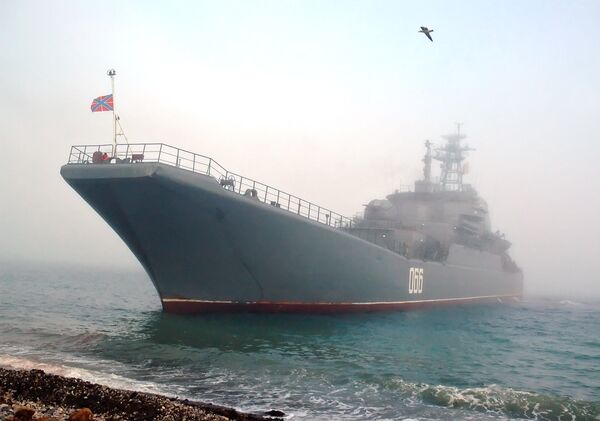The Russian Navy's Northern, Black Sea and Pacific fleets are currently involved in the Vostok-2010 large-scale military exercises in Siberia and the country's Far East.
The exercises involve several dozen warships and support ships. Moreover, the Northern and Black Sea fleets have contributed their largest and most powerful warships - the Pyotr Veliky (Peter the Great) and Moskva guided missile cruisers, respectively.
Naval forces are carrying out simulated combat missions, including anti-submarine warfare (ASW), attacks on warships, repelling a simulated amphibious landing and supporting its own amphibious-landing operation aimed at seizing an enemy beachhead.
The Navy is also practicing cooperation with Air Force units to repel simulated air strikes.
The Vostok-2010 military exercises differ from previous exercises in that they prioritized humanitarian and peacekeeping missions.
The Navy has always ranked among the most expensive and hi-tech branches of the military. Moreover, it sometimes takes decades to build up large battle-worthy naval formations - the longest cycle of any branch.
Mistakes in naval development are extremely expensive, because it can take the lifespan of one or two generations to correct them.
What role will the Russian Navy play in the restructured Armed Forces? How will the Navy look after these extensive military reforms are complete?
Although top political and military leaders say the Navy plays an important role in Russia's Armed Forces, it is obvious that the amount of warship construction and deadlines for projects directly depend on the country's economic potential.
Considering the high cost of building capital warships, their numbers are likely to be limited in the next few decades. Russia will have to strengthen its Navy in some other way if it hopes to be able to deal with the superior forces of a potential enemy.
The prompt re-deployment of capital warships from one remote theater of war to another, called inter-theater maneuvers, is becoming a key element of this strategy. These maneuvers are one element of the Vostok-2010 exercises.
By combining the potential of a few hard-hitting weapons systems, such re-deployment can expand task-force potential many times over. This time, the Navy has established a unit comprising two guided missile cruisers and three anti-submarine warfare ships. Objectively speaking, the Pyotr Veliky and Moskva cruisers wield extremely powerful air-defense weaponry matching the capabilities of U.S. Navy and Japanese Maritime Self-Defense Force warships equipped with Aegis combat systems.
Both Russian cruisers have unprecedented strike potential and are equipped with heavy supersonic cruise missiles, a trademark of the Soviet/Russian Navy.
The Pacific Fleet's Varyag guided missile cruiser, now returning from a trip to the United States, could also be included in this unit, enhancing its potential still further. By cooperating with other Pacific Fleet elements and air force planes, the unit could engage even the most formidable adversary.
It is hardly surprising that such exercises are conducted on the Pacific theater of war, as this region is and will remain one of the most conflict-prone areas for Russia in the next 20-30 years.
Russian-Japanese disagreements over the disputed South Kuril archipelago, called the "Northern Territories" by Tokyo, and Russia's proximity to a powerful China prompt Moscow to find new ways to defend its Far East possessions in the event of a hypothetical conflict.
What will the Navy look like after most of the aging Soviet-era ships are decommissioned within the next 15-20 years?
The state rearmament program for 2011-2020, which is currently under development, stipulates at least 13 trillion rubles ($418 billion) worth of federal-budget funding. If adopted, the program will not facilitate the Navy's large-scale modernization.
In that case, a joint military/civilian shipbuilding program will make it possible to expand the Navy. Although the program's allocations remain unclear, senior defense-industry officials say they will meet minimal naval requirements.
Such requirements are currently as follows: The Navy should be able to defend Russia's coastline from sea attacks, facilitate the operation of the Navy's strategic nuclear forces, support ground-force operations in maritime regions and be able to conduct limited operations in remote sectors of the global ocean.
For these purposes, the Navy should receive warships of all the main classes, including corvettes and destroyers. It should be noted that modern destroyers pack the same devastating punch as guided missile cruisers.
Moreover, the Navy should have large submarine and aircraft formations, as well as coastal-defense and marine units. Analysts say at least 60 main-class ships, including submarines of all classes, corvettes, destroyers and other capital warships, not to mention speed boats and support ships, should be built within the next 20 years.
Under a more optimistic scenario, the Navy would receive even more ships, including aircraft carriers. The experience of the world's leading navies shows that carrier-borne planes and helicopters considerably expand the potential of task forces, turning the Navy into a truly flexible, multi-role and multi-faceted service capable of accomplishing even the most difficult combat missions.
If the Pacific Fleet received just one aircraft carrier with 30-40 warplanes onboard, it would be able to accomplish far more objectives together with available navy elements in case of a hypothetical conflict over the Kuril archipelago and southern Sakhalin.
Moreover, it would be able to more effectively conduct detached operations in remote parts of the global ocean. A combined force consisting of an aircraft carrier, other warships and Mistral-class amphibious assault ships could accomplish just about any objective, including the disengagement of belligerents on a coastal theater of war and engaging the Navy of a theoretical enemy.
No matter how expensive the Navy, weapons systems capable of repelling naval strikes would cost even more.
The opinions expressed in this article are the author's and do not necessarily represent those of RIA Novosti.
MOSCOW. (RIA Novosti military commentator Ilya Kramnik)



